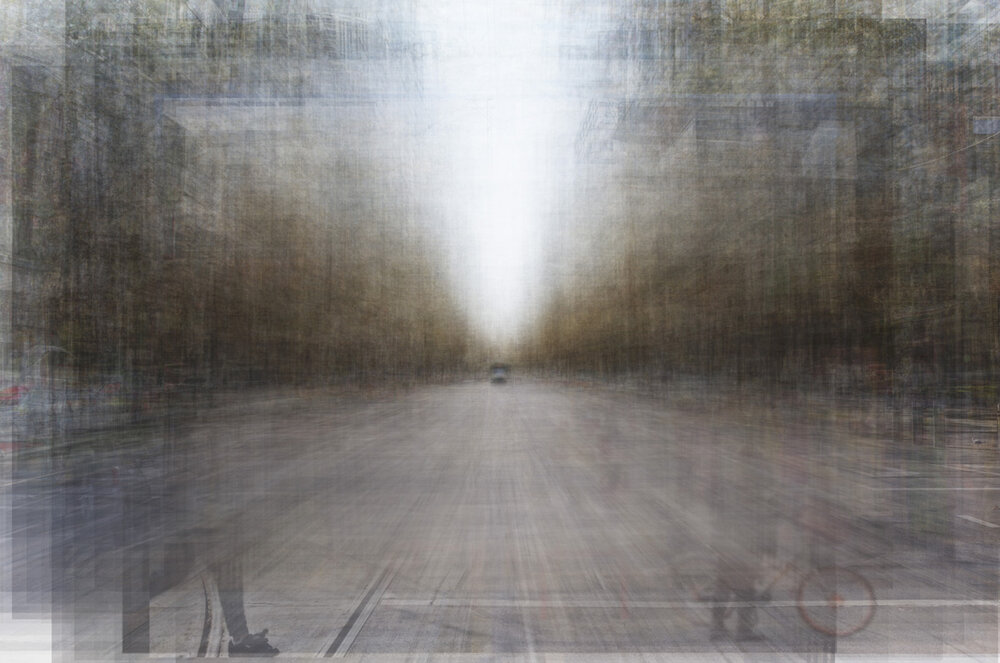
Cyrus Tang, Melbourne City
year of production : 2020
medium : archival pigment print
size : 135 x 90 cm
5 editions , 2 AP
Cyrus Tang is an artist working with analogue technology to create digital photographs that explore memory and loss. Born in Hong Kong, she moved to Australia in 2003 and is now living in Narrm (Melbourne). This migratory experience inspires much of her practice, where memory is a ruin that she reconstructs in labour intensive processes. Her body of work Remember me when the sun goes down (2020) looks at the empty streets of Vermont and the city of Melbourne area during lockdown as an elegy for the future, documenting the social wreckage of COVID-19. Tang photographed these images during the eighth consecutive month of Stage Four lockdown in Victoria, when emergency laws allowed residents out on the streets for only one hour per day, within a five km radius and with a curfew. The artist explains that this moment in time was reminiscent of the 2003 severe acute respiratory syndrome (SARS) epidemic of Hong Kong, which led her to look for street features that differ from those of her city of birth. Thus, her pictures register the eerie absence of people on the streets but also the uncanny presence of scenery that is unique to Australian urban landscapes.
Her piece Power Cables (2020) epitomises this concern by focusing on a single utility pole that is spreading its cables in a barren landscape. As Tang explains, “The power cable and the sky are very different from what we see in Hong Kong and it reflects the uniqueness of the Australian landscape.” The artist made this image by photographing poles with an analogue camera during her allowed exercise time in lockdown. She then used digital technology to superimpose these images and create a ghostly rendering of the column. The outcome resembles a pencil drawing (even though it is photograph) made with blues, dark greens, and sepias—inscribed with blurry lines and spectral forms that spread to the edges like desperate scratches. This stacking of endless imagery also creates a vignette of sorts, evoking the unbearable nostalgia for vintage photography. One meets a perceptual sensation of the image receding, sinking into the depths of the frame while imprinting its form on the wake of its journey. These are the optical traces that collectively form the impression of a blurry memory, a strategy that characterises Tang’ oeuvre, where mental images seem to find form on paper.
This is because memories often feel like Polaroids that we frantically return to, only to find that they become increasingly blurry and shapeless with time. This is a recurrent state of loss, where that which we seek to preserve perpetually evades our grasp. Tang laboriously captures this state of grief in Power Cables by recalling the non-appearance of her city of birth in the Australian urban landscape and capturing a sense of longing that is common to the migrant experience. However, rather than seeking to resolve this absence and distance, she plunges into the depths of melancholic reveries, where she rescues the beauty of yearning. The artist explains that this strategy allows her to remember the circumstances that led her to arrive in Australia and honour the people that she has lost. Therefore, it becomes a generative rather than a debilitating condition.
Looking at Power Cables now—over a year after the eruption of COVID-19 in Australia—there is a sense of resurrection, the impression that Tang’s practice is a magical ritual that revives memories. Indeed, one feels the artist is bringing back echoes from the carnivorous depths of the netherworld, where they would otherwise rest forgotten. This work is evidence of our desire to perverse and immortalise the ever fleeting present, like a zombie in an apocalyptic film. Power Cables reflects this endeavour with its phantasmagorical qualities, which evoke primordial visions of the afterlife even though it depicts a terrestrial scenery.
This is true of the entire series Remember me when the sun goes down, where the mundane becomes fantastical by applying the same technique as Power Cables: photographing locations for extended periods of time, then compositing all images into a single frame. Tang creates these visual cacophonies to depict banal locations with a great deal of pathos, by transforming tram lines, empty roads, the urban sky, train escalators, the supermarket, and the subway. For us in Australia there is something incredibly familiar about these portraits but also decisively uncanny, for they express the subjectivity of a mental image but also the coldness of documentary photography. The artist explains that lockdown afforded her the time to see her surroundings anew, by “going out every day for a walk during the one hour allowed time for exercise and essential activities like grocery shopping, and medical appointments. I used this time to observe, imagine and record the effects of COVID-19 on the landscape, the things that were changing because of it.” These pictures are documents of these changes indeed, now preserved for an uncertain future.